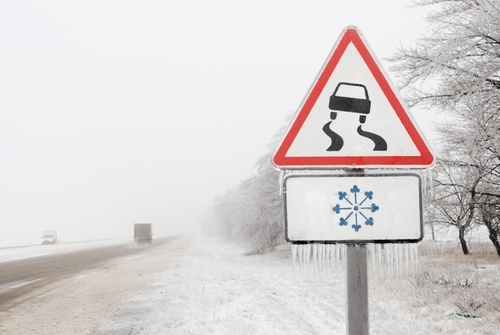Sugar, Spice, and Everything Ice!

Everyone loves a white Christmas, but it can make finishing your shopping and getting to relatives’ houses a challenge. Whether you live in a cold climate or are just traveling to one for the holidays, it’s important to know how to navigate icy conditions. Here are a few tips that will help keep you on your merry way!
In order to maintain traction and avoid skidding, accelerate and decelerate slowly. Remember that everything takes longer when there’s snow and ice on the road; so don’t be in a rush. A normal stopping distance on dry pavement is three to four seconds but on icy surfaces that should be increased to a minimum of eight to ten seconds.
With that in mind, get to know your brakes before an emergency. The best way to stop is by threshold braking—use the ball of your foot to apply firm, steady pressure on the brake pedal. If possible, it’s better to avoid coming to a complete stop. It takes substantially more inertia on snow-covered roads to start from a full stop than it does while your wheels are still rolling.
Avoid accelerating up hills. Applying gas on a snowy incline will only make your wheels spin. Try to get your speed up before you reach the hill and let that inertia carry you to the top. Once you’re at the peak, continue down the hill as slowly as possible. The worst thing you can do on an icy incline is stop—it’s very difficult to start moving again and you could start to roll backwards.
The best winter driving advice is to stay home. If you don’t really need to leave, don’t. Even if you’re a competent winter driver, not everyone else on the road is and it’s just not worth the risk.
We’re always here to answer any questions, just give us a call or send us an email… Visit us online at http://www.roberts-autorepair.com/.
Don't Let the Holiday Pressure Get to Your Tires!
With the hustle and bustle of the holiday season, it’s easy to overlook routine car maintenance items—don’t let checking your tire pressure be among them! Tires are one of the most important safety features of your car. As the only part of the vehicle that comes in direct contact with the road, they are crucial to its drivability. Under inflated tires will negatively affect the stability of your vehicle, cornering, and your ability to brake effectively—all of which are important when driving in winter weather.
Think about it, when a tire has less air in it, a greater portion of its surface is coming into contact with the ground. This will increase the amount of friction between rubber and road, ultimately causing premature wear. Conversely, if a tire’s pressure is too high, not enough of its surface will come in contact with the ground. Your car will feel bouncy, and you will notice a decrease in traction and stopping distances.
So, how often should you check your tire pressure? We recommend at least once a month, if not more frequently. A lot of factors affect tire pressure and they won’t necessarily appear under or over inflated to the naked eye. Additionally, tire pressure changes with the weather—it decreases by about 1lb per every 10 degrees drop in temperature. So if the last time you checked it was in August, by December your tires could be dangerously under inflated.
A Little Winter Wisdom Courtesy of Calvin and Hobbes
